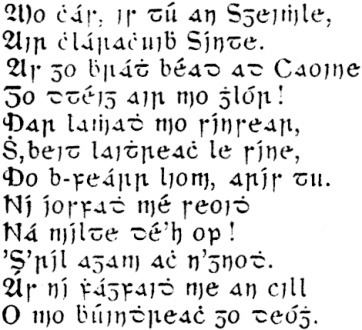 | ||
Scottish Gaelic orthography has evolved over many centuries. Scottish Gaelic spelling is mainly based on etymological considerations.
Contents
- Alphabet
- Arboreal names of the letters
- Consonants
- Vowels
- Vowel consonant combinations
- Epenthetic vowels
- Defunct combinations
- References
Due to the etymological nature of the writing system, the same written form may result in a multitude of pronunciations depending on the spoken variant. For example, the word coimhead "watching" may result in [kʰõ.ət̪], [kʰɔ̃jət̪], [kʰʷi.ət̪], or [kʰɛ̃.ət̪].
Alphabet
The alphabet is known as the aibidil in Scottish Gaelic, and formerly the Beith Luis Nuin from the first three letters of the Ogham alphabet: b, l, n. The alphabet now used for writing the Scottish Gaelic language consists of the following letters of the Latin alphabet, whether written in Roman type or Gaelic type:
a à b c d e è f g h i ì l m n o ò p r s t u ù;Modern loanwords also make use of j k q v w x y z.
From a language internal perspective, the following digraphs are considered single letters:
bh ch dh fh gh ll mh ng nn ph rr sh thOlder manuscripts made use of the acute accent over vowels, but these are no longer used in standard orthography. Since the 1980s the acute accent has not been used in Scottish high school examination papers, and many publishers have adopted the Scottish Examination Board's (the Scottish Qualifications Authority's after 1997) orthographic conventions for their books. The acute accent is still used in most Scottish universities (and several Scottish academics remain vociferously opposed to the SEB's/SQA's conventions) and by a minority of Scottish publishers, as well as in Canada.
Arboreal names of the letters
The early Medieval treatise "Auraicept na n-Éces" ('The Scholars' Primer') describes the origin of alphabets from the Tower of Babel. It assigns tree names and meanings to Ogham, to a lesser extent to Norse Runes, and by extension to Latin letters when used to write Gaelic. Robert Graves' book The White Goddess has been a major influence on assigning divinatory meanings to the tree symbolism. (See also Bríatharogam.) Some of the names differ from their modern equivalents (e.g. dair > darach, suil > seileach).
Consonants
The consonant letters generally correspond to the consonant phonemes as shown in this table. See Scottish Gaelic phonology for an explanation of the symbols used. Consonants are "broad" (velarised) when the nearest vowel letter is one of a, o, u and "slender" (palatalised) when the nearest vowel letter is one of e, i. A "back vowel" is one of the following; o(ː), ɔ(ː), ɤ(ː), u(ː), ɯ(ː), a(ː), au; a "front vowel" is any other kind of vowel.
Vowels
Many of the rules in this section only apply in stressed syllables. In unstressed syllables, the vowels have different values. Only certain vowel graphs exist in unstressed syllables: a, ai, e, ea, ei and i and very infrequently o, oi, u and ui.
Vowel-consonant combinations
Lenited bh, dh, gh, mh are commonly pronounced as vowels or are deleted if they are followed by a consonant. For example, in cabhag the bh is usually /v/ but in cabhlach the bh has turned into an /u/ vowel, yielding /au/ rather than /av/ in the first syllable.
Epenthetic vowels
Where an l, n or r is followed (or in the case of m, preceded) by a b, bh, ch, g, gh, m or mh, an epenthetic vowel is inserted between the two. This is usually a copy of the vowel that preceded the l/n/r. Examples; Alba /aɫ̪apə/, marbh /maɾav/, tilg /tʰʲilikʲ/, arm /aɾam/, iomradh /imiɾəɣ/.
If this process would lead to the sound sequence /ɛɾɛ/, the epenthetic vowel is an /a/ in many dialects. Example; dearg /tʲɛɾak/.
Defunct combinations
The acute accent is no longer used in standard Scottish Gaelic orthography, although it may be encountered in late twentieth century writings, and occasionally in contemporary writings, especially in Canadian Gaelic.
Certain spellings have also been regularised where they violate pronunciation rules. "Tigh" in particular can still be encountered in house names and certain place names, notably Tighnabruaich and Eilean Tigh.
